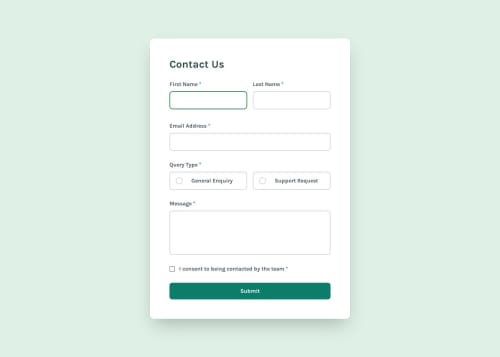Contact Form Validation With ReactJS, and TailwindCSS

Solution retrospective
It was my first time using Tailwind, ReactJS, React-Hook-Form
Despite The project being very simple, It took my few days to finish, It was a good learning experience, I had fun applying What I've learned recently.
What specific areas of your project would you like help with?Problem 1: After Submitting the data, I need to press on consent checkbox 3 times to toggle it again
Problem 2: Pressing tab doesn't focus on queries section
Any feedback would be appreciated.
Please log in to post a comment
Log in with GitHubCommunity feedback
- P@markuslewin
Hi!
I think your consent checkbox counts as a controlled component, since you rely on the value to render the component. This means you have to provide
defaultValuesfor it to reset properly:export function Form() { const { watch, reset } = useForm({ defaultValues: { consent: false, }, }); return <></>; }
Pressing tab does focus the queries section, but it doesn't check the radio buttons. That's how native radio buttons work, so I actually don't think that's a bug. You could add some focus styles for the radio buttons to make it clearer what's happening:
export function Query({ enquiry, value }) { return ( <label className={` has-[:focus-visible]:outline has-[:focus-visible]:outline-offset-2 ${ enquiry === value ? "bg-green-100 border-green-700 before:bg-green-600" : "" }`} > <input type="radio" /> </label> ); }Marked as helpful
Join our Discord community
Join thousands of Frontend Mentor community members taking the challenges, sharing resources, helping each other, and chatting about all things front-end!
Join our Discord